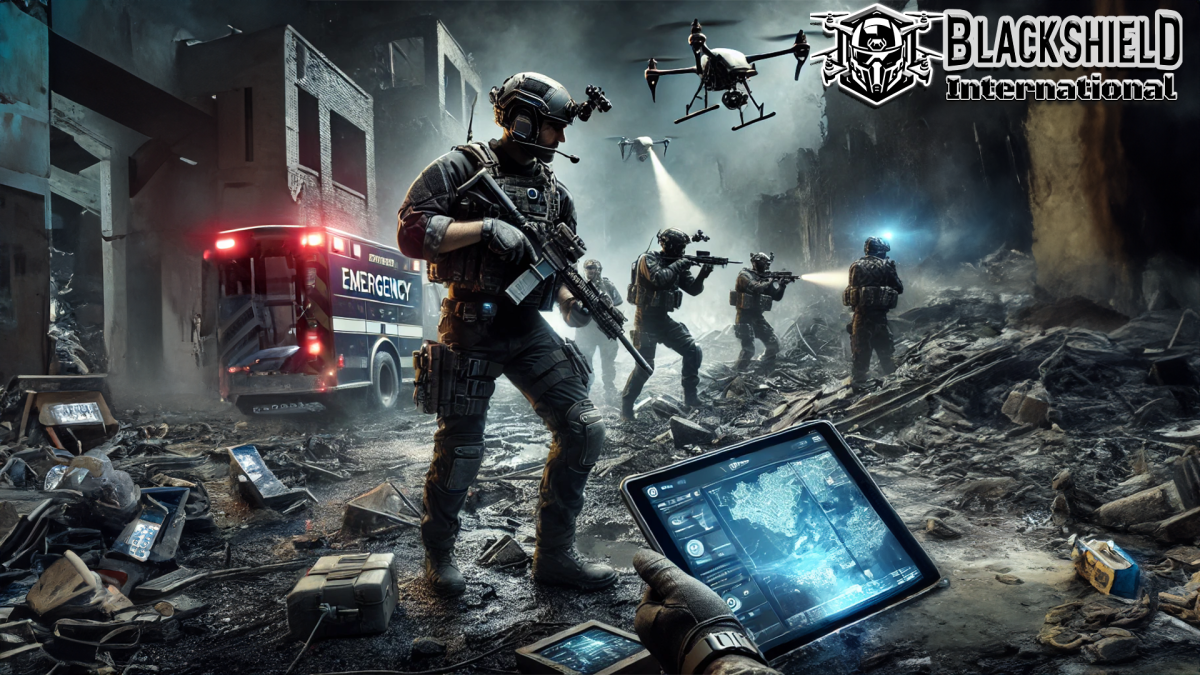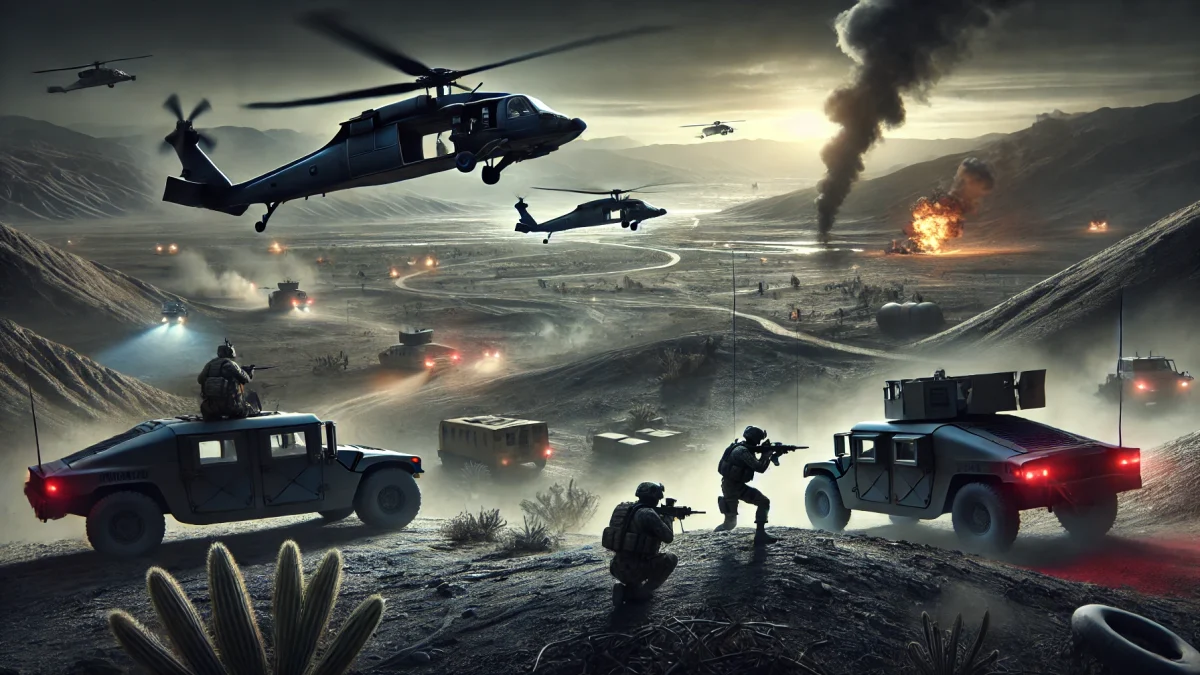The field of emergency management has undergone significant transformations in recent years, and one of the most notable developments has been the increased role of military forces and special operations in humanitarian response efforts. This trend, while introducing a new set of complexities, has also provided unique opportunities to enhance the efficiency and speed of emergency response. For organizations like Black Shield International (BSI), there are valuable lessons to be learned from these evolutions, as well as challenges to navigate. In this article, we will explore the critical role that special operations play in emergency management and how BSI can harness these lessons to maximize our impact.
Military and Special Forces in Emergency Response
The integration of military forces into emergency management has fundamentally changed the way we respond to disasters and crises [2]. The structured, hierarchical nature of military organizations lends itself well to the kind of logistical and operational demands that disasters impose. Military units, with their disciplined approach, advanced equipment, and rapid deployment capabilities, have repeatedly demonstrated their value in complex emergencies. A clear example of this was the U.S. military’s involvement in Hurricane Katrina, where its resources and expertise played a critical role in stabilizing affected areas and providing aid [1].
Special operations forces, in particular, bring unique skill sets to emergency management [3]. These forces are trained to operate in austere environments, make rapid decisions under pressure, and execute complex missions that require precision and adaptability. These qualities are invaluable during large-scale disasters where traditional emergency services may be overwhelmed or lack the capacity to operate effectively. By employing the tactics and strategies used in special operations, BSI can enhance its ability to respond swiftly and effectively in crises.
However, the involvement of military forces is not without its critics. Concerns around the militarization of aid—where humanitarian missions become closely intertwined with military objectives—pose ethical and operational dilemmas. The neutrality and impartiality of humanitarian assistance are cornerstones of effective aid, and military engagement can sometimes blur these boundaries, leading to mistrust among affected communities and other humanitarian actors. Moreover, there is a cultural divergence between military and civilian emergency response teams, which can sometimes hinder collaboration and coordination. Despite these challenges, the benefits of military-civilian cooperation in emergencies remain evident, particularly when guided by well-defined roles and respectful understanding between parties.
For BSI, the lessons learned from military involvement in humanitarian missions are clear: the integration of disciplined, well-trained teams with advanced logistics capabilities can dramatically improve response times and coordination [4]. The key is to maintain a humanitarian-first focus, ensuring that all actions are guided by compassion, respect for affected populations, and adherence to humanitarian principles.
State Limitations in Emergency Management
Emergency management is traditionally seen as a core responsibility of the state. Governments are expected to safeguard their citizens during crises, yet reality often falls short. Bureaucratic inefficiencies, slow mobilization, and inadequate resources can severely limit the effectiveness of state responses [5]. The COVID-19 pandemic starkly highlighted these limitations—even well-developed nations struggled to adapt and respond swiftly. For example, a study in the Journal of Comparative Policy Analysis pointed out that varying state capacities and political regime types played a key role in determining the effectiveness of national responses to COVID-19 [6].
This is where organizations like Black Shield International come in. Independent, agile, and mission-focused groups can act where state responses falter, providing complementary capabilities. By integrating best practices from both military and civilian emergency management, BSI can help fill the gaps left by traditional state actors. We envision a system where our values and agility complement the state’s authority, providing a holistic safety net for communities in times of crisis.
The Role of Black Shield International (BSI)
Black Shield International is uniquely positioned to bridge the gap between state limitations and the benefits of military efficiency. Guided by Orthodox Christian values, BSI can build on the principles of compassion, humility, and service, while also employing the strategic discipline that makes military operations effective. Our goal is to harness the strengths of both worlds—ensuring disciplined and coordinated responses without succumbing to the pitfalls of a militarized approach.
BSI’s approach draws from the insights of its comprehensive business plan, blending tactical efficiency with a strong community focus. We offer a range of services, from tactical training and recreational combat sports to advanced security and intelligence solutions. By leveraging our multifaceted expertise, BSI aims to create a robust emergency management response capability that serves both local communities and government needs.
To achieve this balance, BSI can recruit special operations veterans and trained personnel who understand not only the utility but also the limitations of a purely military approach to crisis response. This provides a unique opportunity to develop a response model that is both efficient and humane, emphasizing the value of community trust and local context. Additionally, adopting a federated structure—akin to the Commandery system of historic knightly orders—would offer local autonomy while maintaining central oversight, fostering both flexibility and cohesion in our operations.
The federated model helps mitigate some of the risks associated with centralized bureaucracies, such as corruption or inefficiency, by empowering local leaders while ensuring consistent support and coordination. Local Commanderies would act autonomously to assess needs and respond rapidly, but they would still benefit from a shared pool of resources, strategic guidance, and best practices coordinated at the central level.
Leveraging Our Unique Capabilities
BSI’s business plan emphasizes a diverse array of capabilities that position us to excel in emergency management. These include:
- Advanced Technological Integration: Our Intelligence and Risk Platform SAAS leverages AI and machine learning to analyze vast amounts of data, providing real-time intelligence that enhances decision-making in crisis situations. This technological edge allows BSI to offer a level of situational awareness that is often lacking in traditional emergency response frameworks.
- Special Operations Expertise: By incorporating veterans of special operations forces, BSI benefits from their specialized training, experience in crisis management, and ability to operate effectively under pressure. This expertise ensures that our teams are capable of rapid response and adept at handling complex and dynamic situations.
- Tactical and Recreational Training: BSI’s tactical training programs, which include everything from small unit tactics to survival skills, are designed to prepare not only our members but also the broader community for crisis situations. The recreational combat sports segment, such as paintball and airsoft, serves as both a training ground and a community engagement tool, fostering teamwork and resilience.
- 3D Printing and Product Development: By utilizing our advanced 3D printing capabilities, BSI can produce customized tactical gear and equipment on-demand, ensuring that our responders are equipped with the best tools available. This capability also allows us to adapt quickly to emerging needs, providing bespoke solutions that enhance our operational readiness.
- Community Engagement and Philanthropy: Central to our ethos is a commitment to community support. BSI actively engages in charitable activities aimed at uplifting local communities, which not only strengthens community ties but also enhances trust—an essential element in any effective emergency response.
Challenges in Leveraging Special Operations for Humanitarian Aid
While the integration of special operations techniques and personnel into emergency management brings clear advantages, it also presents unique challenges that BSI must address:
- Cultural Differences: Special operations forces are trained for combat, and their methods may not always align with the ethos of humanitarian work. Ensuring that personnel understand the importance of neutrality, compassion, and community-centered approaches is crucial.
- Community Trust: The presence of military-trained personnel in a humanitarian setting can lead to apprehension among affected communities. BSI must prioritize transparency, community engagement, and clear communication to build and maintain trust.
- Balancing Efficiency with Humanity: Special operations are focused on mission success, often prioritizing efficiency and speed. In humanitarian operations, however, the well-being of affected populations must always come first. BSI’s training programs must emphasize empathy, patience, and cultural sensitivity to ensure that our responses are as humane as they are effective.
Historical Inspiration and Ethical Foundations
In crafting BSI’s role in emergency management, it is helpful to draw inspiration from our spiritual and historical roots. The principles of service, compassion, and justice—core tenets of our Orthodox Christian faith—serve as guiding lights for our actions. The teachings of the Patristic Fathers, as well as the example set by historical figures like Saint Justinian, emphasize the importance of serving those in need, even when it requires stepping outside of one’s comfort zone.
Raymond de Puy, the second Grand Master of the Knights Hospitaller, provides an exemplary model of leadership in balancing discipline with compassion. Under his guidance, the Hospitallers maintained a high degree of organizational efficiency while never losing sight of their mission to care for the sick and poor. BSI can adopt similar principles, striving to combine logistical precision with empathy, discipline with compassion, and strategic strength with a clear humanitarian focus.
Opportunities for the Future
The future of emergency management is evolving, with new opportunities emerging from technology and innovative organizational models. BSI can leverage advanced geospatial intelligence, unmanned aerial systems, and modern communication methods—tools that are often underutilized in traditional humanitarian operations. The integration of these tools with a federated command structure provides a powerful combination of situational awareness and local adaptability, allowing us to operate efficiently in a diverse range of crisis scenarios.
Additionally, BSI’s expansion into government contracting, intelligence services, and security solutions represents a strategic growth area. By positioning ourselves as a trusted partner for government agencies, we can help fill critical gaps in national and local emergency preparedness, leveraging our veteran-owned status and advanced technological capabilities to secure key contracts that align with our mission.
BSI also has an opportunity to expand its role in community resilience. By providing training programs for local communities in areas like first aid, disaster preparedness, and survival skills, we empower individuals to take proactive steps in safeguarding their families and neighborhoods. This grassroots approach not only enhances resilience but also fosters a culture of self-reliance and mutual support, furthering our mission of building strong, interconnected communities.
By embracing these technological advancements and historical lessons, BSI is not only poised to assist in times of immediate crisis but also to contribute to building long-term resilience within the communities we serve. This aligns with our mission of empowering individuals and communities, ensuring that they are better prepared to face future challenges.
Footnotes
- Council on Foreign Relations. (2005). The U.S. Military’s Response to Hurricane Katrina. Retrieved from https://www.cfr.org
- Stoddard, A., Ferris, F., & Harmer, A. (2006). The Militarization of Aid. Humanitarian Outcomes.
- Center for Disaster Philanthropy. (2023). Special Operations Forces in Disaster Response. Retrieved from https://disasterphilanthropy.org
- Heaslip, G., Sharif, A. M., & Althonayan, A. (2012). Logistics and Supply Chain Management in Disaster Relief Operations. Journal of Humanitarian Logistics and Supply Chain Management.
- International Federation of Red Cross and Red Crescent Societies. (2019). World Disasters Report 2019: Leaving No One Behind.
- Capano, G., Howlett, M., Jarvis, D. S., Ramesh, M., & Goyal, N. (2020). Comparative COVID-19 Responses: Crisis, Inefficiencies, and the Role of State Capacity. Journal of Comparative Policy Analysis: Research and Practice.


